Pond owners frequently ask this question about “How come my garden is so green?” and along with How To Keep Algae Out Of Pond?
This post will show you how to remove string algae from your pond using natural methods rather than harmful algaecides.
However depending on the type of algae in your pond, you’ll need to use different techniques to get rid of it.
For many pond enthusiasts, green water and string algae are typical issues. Algae can get caused by an imbalance in your pond’s ecology.
Further, pond algae may be detrimental to your pond’s health. Further algae may clog filters and choke out plants if there are too many of them.
Although tiny amounts of microscopic floating algae can be helpful to the environment, excessive numbers must get regulated to safeguard your pond. It’s essential to discover what’s generating the algae bloom in your pond.
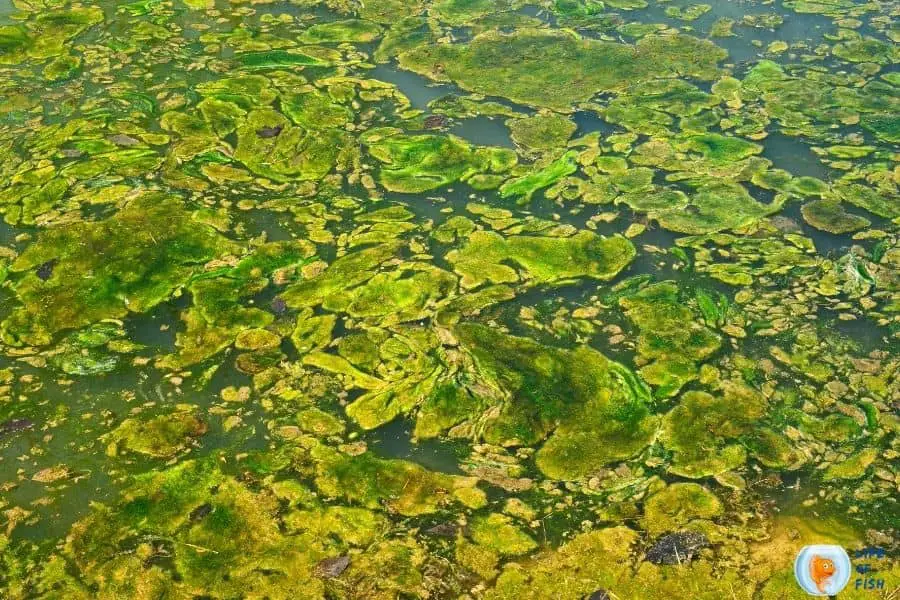
What is Pond Algae?
Jump To
Because scientists categorize or name algae differently, many people refer to all aquatic plants as “pond algae.”
Actually, Algae in a pond are challenging to describe. The alga, on the other hand, is a simple creature. It gets made up of one or more cells that have got joined together to form a colony.
Although algae generate oxygen, a beneficial byproduct, but they quickly breathe when sunlight is scarce at night.
This respiration depletes the oxygen in the pond by converting stored carbohydrates and oxygen into carbon dioxide. Pond algae may get divided into two types:
String Algae or Hair Algae:
These filamentous species attach to rocks and waterfalls by growing long strands. They ultimately tangle and create thick, unattractive mats that can double in weight in as little as 24 hours.
Green Water:
These single-celled creatures that float in water are so tiny that they get past even the best filters.
There can be as many as five million algae cells per milliliter of pond water if the conditions are right, indicating enough nutrients and sunlight.
Pond algae can harm aquatic plants. Algae do not affect all aquatic plants in the same way. It’s also important to remember that not all algae are suitable for your pond.

What causes Pond Algae?
The most common algal causes in lakes and ponds include pollution, light exposure levels, water movement, turbidity, and temperature.
These typical factors, when combined, can create significant algal blooms and surface covering in your pond or lake.
They differ from one location to the next. However, staying ahead is critical because some algae forms may make humans and pets sick, such as blue-green algae or cyanobacteria.
Is Algae Dangerous?
Algae aren’t all harmful. Some algae, such as plankton algae, play an essential part in your pond or lake’s food chain and ecosystem.
If algae and algae-related problems are prevalent in your water, they can represent a severe hazard to your aquatic animals as well as you.
Dead Zones:
Algae blooms can reduce oxygen levels in the water by making a dead zone or a region where aquatic plants and animals cannot live.
Toxic:
Toxins from blue-green algae can cause vomiting and diarrhea in animals. High amounts of exposure to the toxins can result in liver failure, which can be fatal.
People exposed to these poisons may experience gastrointestinal symptoms and liver failure, but skin rashes, sneezing, coughing, eye discomfort, and a runny nose are more frequent in humans.
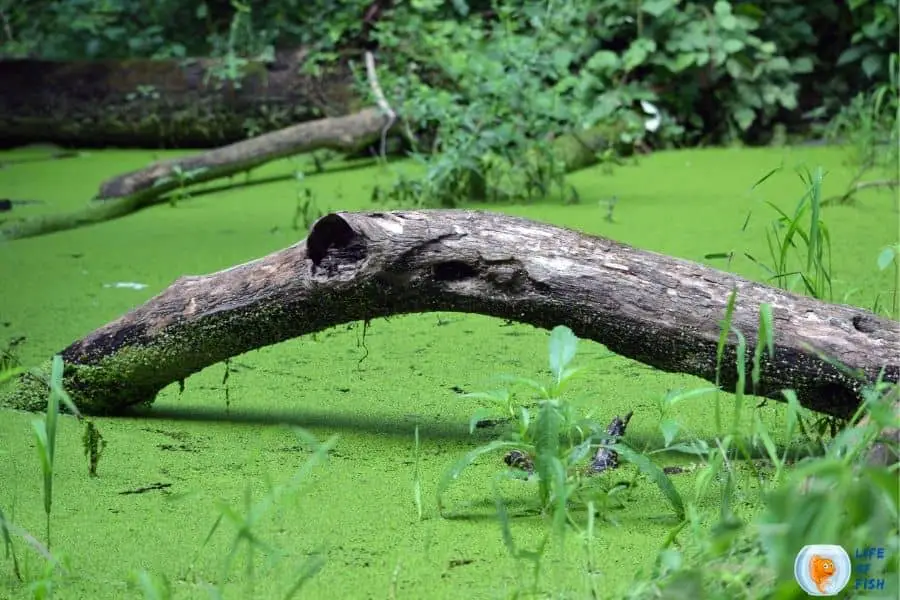
Step by step guide to removing the algae in your garden pond
One of the reasons many individuals ignore a garden pond is that they are bored of the upkeep. A well-constructed pond, on the other hand, maybe very simple to maintain.
Step 1: String Algae removal – Physically
The most effective technique to remove string algae is to remove the most important parts at the tree’s base.
Because the algae are flexible and soft, removing many of them at once can be difficult.
Physically eliminating algae from your pond is the quickest method to clean it.
The hand approach is more straightforward since the strands are thin and tricky to separate from bristles. It’s essential to do so before treating the algae to prevent deterioration.
Step 2: Treating the Water and Getting Rid of the Remaining Algae
Although some sources recommend using a pond algaecide to kill the remaining algae, we do not recommend any unnatural chemicals.
We stick to natural solutions for algae control to speed up the process. The natural green hair-like or carpet/blanket, algae on pond walls, and other rocks should be left alone.
Step 3: Add Extra Plants and Remove Decay
Increase the oxygen level of your pond by adding fast-growing, reproducing plants. Make careful to get rid of any rotting plants first since they won’t assist you battle algae.
Choose plants that will grow large, use a lot of nutrients, and require little maintenance.
Step 4: Find the Cause of the Algae Growth
You can test your water for possible causes of string algae. If you notice that algae are growing at an alarming rate, it’s time to examine the pond chemistry. High levels of pH and phosphorus often cause algae blooms.
pH can be caused by excessive plant growth, clearing algae blooms, overstocking fish, and introducing foreign materials (untreated concrete, limestone/granite rocks, etc.).
Phosphorus levels are most commonly caused by fertilizers that have leaked into pond water. The pond also has iron from grass clippings and fertilizers that have leaked into it.
Grab the green grass blades immediately.
Step 5: Feed Koi and Fish Less to Reduce Nutrient Excess
Overfeeding fish, which adds extra nutrients to the water, is one of the most common mistakes made by pond owners.
If any food remains uneaten in the pond, you’ve overfed your fish.
You enhance the fishes’ demand for other items in the pond by offering less.
As if it were algae! This summer, try feeding your fish less and see how quickly they can cut through a string algae mess.
Bonus Step: Ultraviolet (UV) Clarifiers
Use UV clarifiers to fight green water by exposing suspended single-celled algae to extremely high amounts of ultraviolet radiation, which kills the algae’s capacity to reproduce.
UV clarifiers get made up of a UV-emitting tubular fluorescent bulb.
The bulb is encased in black, opaque housing because UV light is damaging to the human eye.
Pond water enters via the intake tube of the clarifier and circulates the UV lamp. The UV light kills the suspended algae, forcing them to cluster together into large enough particles to be filtered out, and then it exits the clarifier.
Finally, contaminants get removed from the water before returning to the pond using a mechanical and biological filter.
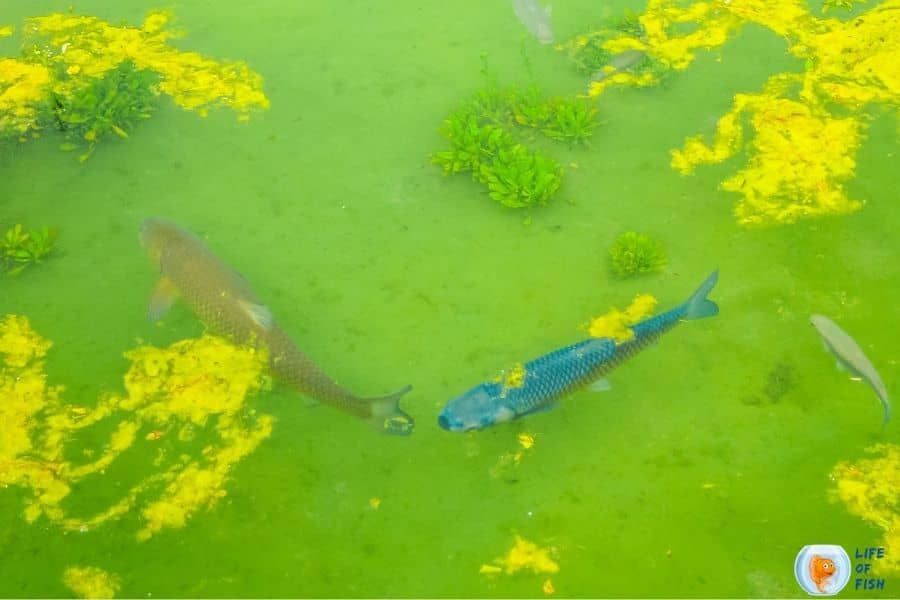
How To Keep Algae Out Of Ponds? Factors that play a crucial role in keeping your Pool Clean
So, How To Keep Algae Out Of Ponds? Make sure your pond’s ecology is in good health.
These few factors can help you maintain a beautiful, well-balanced pond while preventing algal growth.
There Are Too Many Fish
Fish are one of the most common sources of algae in fish ponds. Any pond would benefit from the addition of fish.
However, if your water garden has too many fish, it may be necessary to relocate some. As fish develop and spawn, overcrowding is a possibility. Your fish will have to live in a small space.
Your filtration system may also be unable to handle the increased waste created. If your fish multiply, your pond will ultimately become overcrowded.
What you feed your fish and how often you feed them can impact the quantity of trash they produce. Algae are fond of fish excrement.
Maintaining a fish population of one or two goldfish or two to three koi per 200 gallons will help things run more smoothly.
Too much Debris
Plants, such as algae, consume the nutrients in ponds. The less algal food there is, the more plants there are.
Plants can also assist in screening your pond from direct sunshine, preventing algae growth. Keep in mind that you’ll need to clean up the pond of any dead plant stuff.
Otherwise, you’re providing algae with a feast of organic matter.
Cleaning your pond in the spring is a great way to keep algae at bay.
Use a pond vacuum to maintain it clean throughout the season. Cleaning your water garden in the fall isn’t recommended unless it’s essential.
Mechanical Filtration
A sound filtration system will ensure that your water is clean and free of contaminants. The water column gets filtered via mechanical filtration.
Debris is removed and collected in the filter box or skimmer as the water passes through the pond filter.
The size of the pond influences the filter rating.
A giant filter, on the other hand, may be necessary for extensive fish-load water gardens.
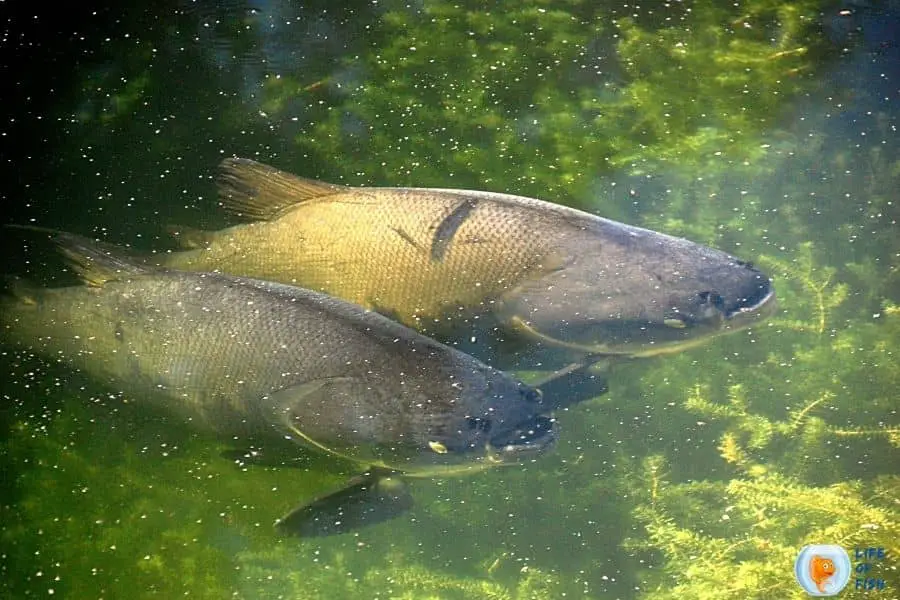
Insufficient Beneficial Bacteria
Algae may get managed by using helpful microorganisms regularly. These bacteria produce harmless gas by consuming extra nutrients and detritus.
These bacteria can break down nutrients that flourish in high-oxygen environments.
Algae in a fish tank will ultimately die if there aren’t enough nutrients to keep them alive.
Your filter pads are an ideal environment for healthy microorganisms to flourish. If you clean your filter pads too frequently, your beneficial bacteria will get killed, whether daily or weekly.
You may lightly rinse them if the water doesn’t flow through the filter. By periodically introducing beneficial bacteria to your pond, you build and develop an ecosystem that limits the number of algae available.
Inadequate Aeration
The survival of beneficial bacteria, like that of your fish, is dependent on oxygen. A fountain or waterfall may not be enough to keep your pond oxygenated.
An aeration kit can help your pond acquire more oxygen.
Furthermore, these kits are less expensive to operate than pumps. Beneficial microorganisms respond well to aeration.
These bacteria will become more active and better at what they do.
The systems circulate the water and increase the dissolved oxygen levels in your pond by forcing air via a diffuser or air stone.
Indoor Vs. Outdoor pond Maintenance
If you own an indoor pond, you understand the significance of creating a regular maintenance schedule to keep your pond clean, the water fresh and clear, and your equipment, such as the pump, filter, and heater, operating safely and effectively.
It doesn’t matter if you have an outdoor or an indoor pond. The maintenance requirements for both types of ponds are essentially the same.
One of the most critical differences between indoor and outdoor pond care is an indoor pond utilized all year.
Outdoor ponds are also more susceptible to pollutants from the outside environment, such as leaves and other debris.
Regular checking is more critical for indoor ponds, which may surprise you.
Although direct sunshine is a good oxidant and can naturally minimize algae development, it isn’t easy to acquire natural sunlight consistently on the surface of indoor ponds.
UV water treatment devices are now available to deal with the problems of a dark pond.
Proper pond maintenance is necessary regardless of the type of pond you possess, but indoor ponds may take a little more attention and effort to keep them clean and safe.
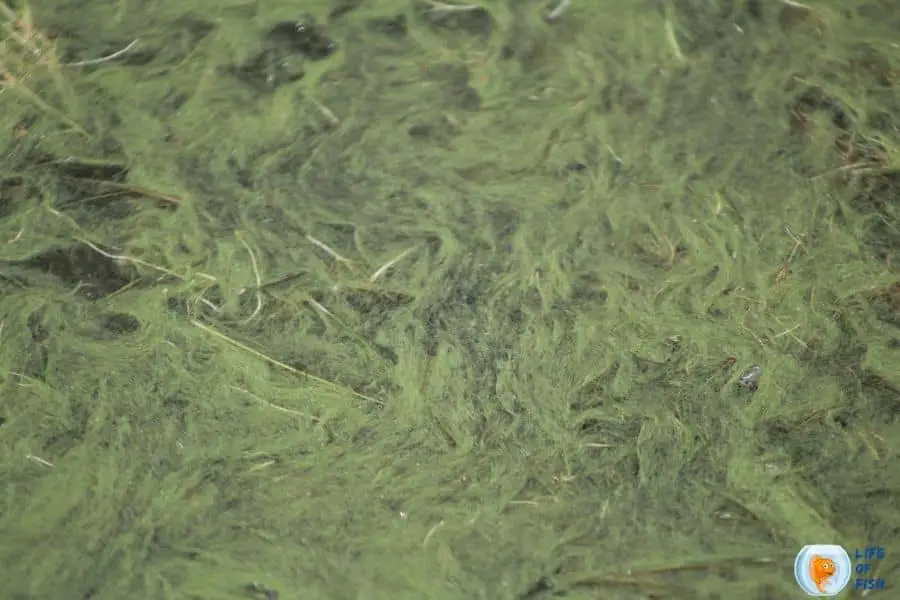
Conclusion
We hope this article has shown you how to prevent algae out of a pond and deal with it if it does appear.
Please don’t hesitate to contact a team of experts if you have any more questions about preventing algae bloom in your pond.
Read Next: Did You Know These Fascinating Facts About Drumfish?
